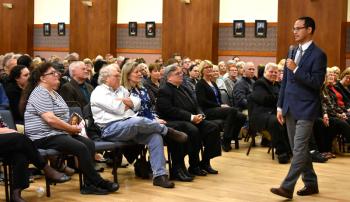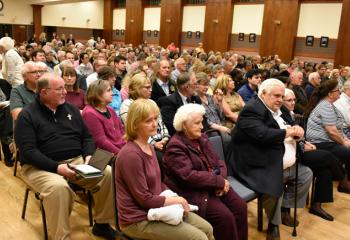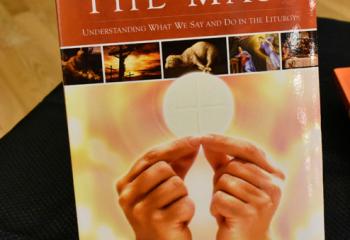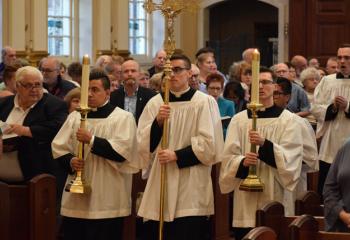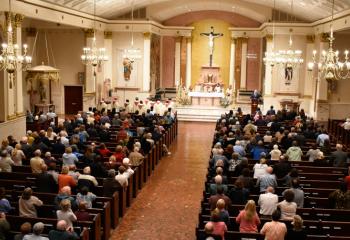By TAMI QUIGLEY Staff Writer
“Our prayers, rituals and symbols all have roots in our great tradition and Scripture” said Dr. Edward Sri, presenting “A Biblical Walk Through the Mass: Understanding What We Say and Do in the Liturgy” Oct. 4 at the Cathedral of St. Catharine of Siena, Allentown.
Do you ever wish you could get more out of Mass? Those attending discovered how all the prayers, symbols and rituals in the liturgy can come alive for us once we understand their biblical roots.
Sri is a theologian, author and Catholic speaker who appears regularly on EWTN. He was also featured speaker the next day at the Diocesan Women’s Conference.
The event was a partnership between the Diocesan Secretariat for Catholic Life and Evangelization and the Office for Divine Worship. Rick Dooley, assistant director of the Diocesan Office of Adult Formation, introduced Sri to clergy and laity gathered.
Sri said the first prayer of the Mass, the Sign of the Cross, is itself a prayer. “It’s a very powerful prayer traced back to Scripture, to call on the name of the Lord and invite his presence.”
He added the ritual of tracing the cross over our bodies goes back to the early Christians, who did it to invoke God’s presence and invite him into their lives.
“The Mass shouldn’t be only on Sunday – bring the liturgy into our daily lives,” Sri said. For example, make the Sign of the Cross anytime, such as when facing a temptation or problem.
Sri said “The Lord be with you and with your spirit” is spoken over and over in the Old Testament when God called people such as Moses, Joshua and Gideon to do something daunting. Mary too heard these words when visited by the angel Gabriel.
“This means we are called to go on a sacred mission – get ready to hear his word and receive him in the Eucharist,” Sri said. “The introductory rites prepare us to encounter Christ.”
Focusing on “Lord have mercy,” Sri said we’re trusting ourselves to God’s loving mercy and we can be forgiven. “Then we sing his praises in the Gloria, the climax of the introductory rites. The angels are the inspiration of the Gloria, when they welcomed Christ in the Christmas story. We welcome that same Son of God as we are about to encounter him in the bread and wine.”
“God’s word still touches our hearts today,” Sri said while discussing the Liturgy of the Word. “Unlike other Christian denominations when sometimes the pastor picks the readings – which is wonderful – I’m glad we have a three-year lectionary cycle. For daily Mass it’s a two-year lectionary cycle.”
Why do we recite the creed every week? “The key is ‘I believe.’ Biblically, belief isn’t just about believing something in your mind,” Sri said. “It’s a personal entrusting of myself to Jesus, the one whom we say we believe.”
During the Liturgy of the Eucharist, when the priest says “Lift up your hearts” he is summoning us to give God our best.”
Discussing “This is my body,” Sri said it’s sad most Catholics don’t believe in the real presence in the Eucharist. “It still looks like bread and wine, but we believe it’s been changed to the body and blood of Jesus.”
“Imagine being in the Upper Room when Jesus says, ‘this is my body, this is my blood,’” Sri said. Noting the Last Supper took place on Passover, Sri said both are a memorial, a past event that is biblically made present.
Sri said with the words ‘“Do this in remembrance of me,’ Jesus is commanding us to make this present for future generations.”
Sri said “Blessed are those who are called to the supper of the Lamb” is taken from Revelation 19.
“The priest is alluding to the fact it’s a marriage feast, like God is the groom and Israel the bride,” Sri said. “Even when Israel turns her back, God wants to woo her back.”
Monsignor Francis Schoenauer, pastor of the cathedral and one of the approximately 20 priests concelebrating the Mass, reflected on the importance of Mass after the event.
“Mass is a commonly used word that refers to the celebration of the Eucharist. And the Eucharist is ‘the source and summit of the Christian life.’ All the other sacraments are bound up with the Eucharist and are oriented toward it,”
Monsignor Schoenauer said, quoting the Catechism of the Catholic Church.
“For in the Eucharist is contained the whole spiritual good of the Church, namely Christ himself. By the Eucharistic celebration we already unite ourselves with the heavenly liturgy and anticipate eternal life when God will be all in all,” said Monsignor Schoenauer, referring to the catechism.
“The Eucharist is the sum and summary of our faith. St. Irenaeus wrote ‘Our way of thinking is attuned to the Eucharist, and the Eucharist in turn confirms our way of thinking.’”
“We are all called to continue to grow in love for Jesus and to share the Gospel,” said Dooley. If we are to do either of these, we need to continue to enrich our understanding of the faith – essentially who Jesus is as he expresses himself through the Church.
“Continuing to learn about the faith is not something we do to gain more knowledge, but something we do to grow closer to a person, that is the person of Jesus Christ.”



